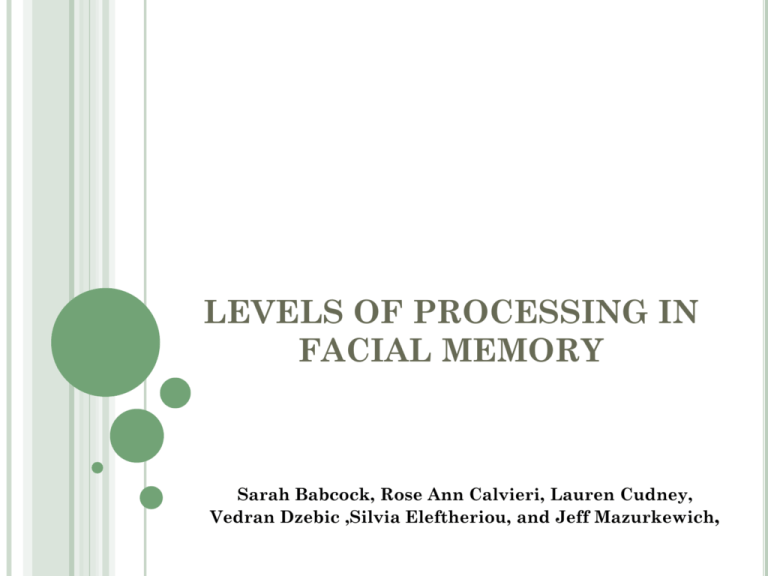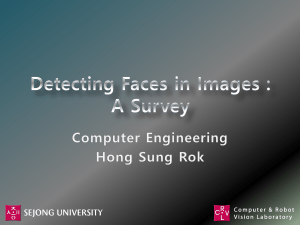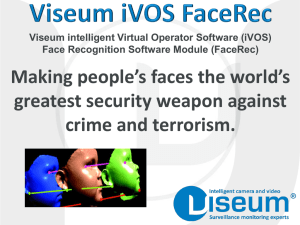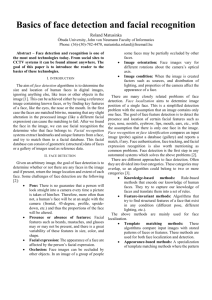3MM3_P2Presentation_Group1
advertisement

LEVELS OF PROCESSING IN FACIAL MEMORY Sarah Babcock, Rose Ann Calvieri, Lauren Cudney, Vedran Dzebic ,Silvia Eleftheriou, and Jeff Mazurkewich, TOPIC DEVELOPMENT Progression of ideas for possible studies: Initial thought: Combine spatial memory with decision making task Replaced spatial memory with word memory Word memory is well studied, we wanted to approach memory from a different angle Memory involving different levels of processing regarding objects Decided to examine faces instead of objects RATIONALE FOR THE STUDY We encounter faces constantly, making facial memory a crucial skill for social interactions Examining techniques of facial memory can potentially improve ease of everyday social interactions LITERATURE: CRAIK & TULVING (1975) Experiment Processing words at different levels Subjects presented with words & asked questions to various levels Shallow = same font Medium = counting letters in word Deep = synonyms Results Better memory recall for words processed at a deeper level LITERATURE: BRUCE & VALENTINE (1985) Experiment Priming task: Subjects were shown the name or photo of a celebrity Recognition task: Subjects were then shown a series of photos of celebrities and asked to name them The subject had seen either the name, same photo or a different photo of the same celebrity in the priming task Results Better memory for faces which subject’s had seen pictures of in the priming task (same or different) LITERATURE: GEGHMAN & MULTHAUP (2004) Experiment Source memory for faces (internal or external) Questions were asked about faces in a presentation of facial images The subject either generated the answer or the answer was provided for them (accompanied the face) Results Subjects were better at source memory for faces which asked them to generate answers (internal), than for faces accompanied by the answers (external) PURPOSE OF THE EXPERIMENT Purpose: To determine whether different questions can elicit deeper levels of processing To establish if deeper levels increase subsequent memory on a facial recognition task LEVELS OF PROCESSING Questions: 1) 2) 3) 4) What is this person’s most attractive feature? What job do you think this person has? How old is this person? What is this person’s gender? Examine whether any of these questions will result in deeper level of processing, measured by accuracy of facial recognition HYPOTHESIS If different levels of facial processing can be achieved, deeper level processing will lead to better recognition of faces Hypothesized to elicit shallower processing: Questions about gender and age Hypothesized deeper processing: Questions about attractiveness and occupation Kirkland, Reynolds and Pezdek (1992) METHODS Subjects 30 subjects 24 in experimental group 6 in control group All Mac undergrads Age range 18-24, Mean 20 METHODS Stimulus/Materials Study Task 32 faces Experimental group Each Face paired with one question Control group No questions presented METHODS Stimulus/Materials Recognition Task 60 faces (28 novel) Have you seen this face in the previous presentation? Yes/No responses All subjects given same task METHODS Cover Story Study Task – Subjects were told: There will be questions about the faces They need to answer as quickly as possible the questions We are looking at how much you can tell about a person by their appearance Recognition Task: Subjects were naïve of recognition task to follow the study task LEVELS OF PROCESSING Questions: 1) 2) 3) 4) What is this person’s most attractive feature? What job do you think this person has? How old is this person? What is this person’s gender? Examine whether any of these questions will result in deeper level of processing, measured by accuracy of facial recognition SLIDESHOW EXAMPLE: STUDY TASK ATTRACTIVENESS? AGE? GENDER? JOB? SLIDESHOW EXAMPLE: RECOGNITION TASK DATA COLLECTION Study Task Recorded subject’s responses to questions Recognition Task Recorded if the subject answered yes or no STUDY TASK DATA SHEET Subject # Question Orders Group Number Picture # S’s response 1 2 3 4 1 a d b c 2 b c a d 3 c b d a 4 d a c b 5 a d b c 6 b c a d RECOGNITION TASK DATA SHEET Subject # Recognition Task Ss Response Sheet Picture Number 1 2 3 4 S’s response Recognition task slide #'s S’s Correct Responses 2 54 0 0 0 0 4 21 a d b c 6 27 c b d a 8 45 0 0 0 0 10 43 0 0 0 0 12 14 b c a d 14 41 0 0 0 0 16 28 d a c b 18 24 d a c b RESULTS Group Results (Experimental & Control) Independent t-test Descriptives One-way ANOVA Post-hoc (Bonferroni) GROUP STATISTICS Group Statistics Group Sstotal 1 2 N Mean Std. Deviation Std. Error Mean 24 49.4167 5.19964 1.06137 6 40.6667 6.37704 2.60342 INDEPENDENT T-TEST Independent Samples Test Levene's Test for Equality of Variances t-test for Equality of Means 95% Confidence Interval of the Difference Ss total Equal variances assumed Equal variances not assumed df Sig. (2-tailed) Mean Difference Std. Error Difference F Sig. t Lower Upper .033 .858 3.531 28 .001 8.75000 2.47783 3.67440 13.82560 3.112 6.760 .018 8.75000 2.81146 2.05373 15.44627 DESCRIPTIVES Descriptives Data 95% Confidence Interval for Mean N 1 2 3 4 Total Mean Std. Deviation Std. Error Lower Bound Upper Bound Minimum Maximum 24 6.7917 1.02062 .20833 6.3607 7.2226 5.00 8.00 24 6.0833 1.44212 .29437 5.4744 6.6923 3.00 8.00 24 5.2500 1.89393 .38660 4.4503 6.0497 1.00 8.00 24 5.7500 1.32698 .27087 5.1897 6.3103 3.00 8.00 96 5.9688 1.53865 .15704 5.6570 6.2805 1.00 8.00 ONE WAY ANOVA ANOVA Data Sum of Squares Between Groups Mean Square df 30.115 3 10.038 194.792 92 2.117 224.906 95 Within Groups Total F 4.741 Sig. .004 POST HOC Multiple Comparisons Data Bonferroni 95% Confidence Interval (I) Questions (J) Questions 1 2 3 4 Mean Difference (I-J) Std. Error 2 .70833 .42005 .571 -.4243 1.8410 3 1.54167* .42005 .002 .4090 2.6743 4 1.04167 .42005 .090 -.0910 2.1743 1 -.70833 .42005 .571 -1.8410 .4243 3 .83333 .42005 .301 -.2993 1.9660 4 .33333 .42005 1.000 -.7993 1.4660 1 -1.54167* .42005 .002 -2.6743 -.4090 2 -.83333 .42005 .301 -1.9660 .2993 4 -.50000 .42005 1.000 -1.6327 .6327 1 -1.04167 .42005 .090 -2.1743 .0910 2 -.33333 .42005 1.000 -1.4660 .7993 3 .50000 .42005 1.000 -.6327 1.6327 *. The mean difference is significant at the 0.05 level. Sig. Lower Bound Upper Bound LIMITATIONS OF CURRENT STUDY 1) Response time: 5 second time limit Subjects provided arbitrary responses May have focused more on the question than actual face Further studies: allow slightly more time for subjects’ responses LIMITATIONS OF CURRENT STUDY 2) Occupation Question: Was predicted to elicit deeper processing Answer didn’t require face processing Future studies: questions relying more on facial features (I.e ethnicity, cosmetic surgery) LIMITATIONS OF CURRENT STUDY 3) Facial Images: Atypical facial images compared to participants and people within the participants’ environment Non significant results maybe due to quality of faces Faces presented in grey-scale : require deeper processing Future studies: Use of coloured images is more realistic Use more updated faces similar to those within participants’ social environment LIMITATIONS OF CURRENT STUDY 4) Number of Images: Study task: 32 faces Recognition task: 60 faces Future studies: More faces in study and recognition tasks Increase power LIMITATIONS OF CURRENT STUDY 5) Control Group: Smaller than experimental group Future studies: Larger number of subjects in control group size = increase power Within-subjects control group: Have some pictures without any questions in the slideshow IMPLICATIONS If significant: Faces and words are processed similarly Improve peoples ability to remember new acquaintances Eyewitness testimony CONNECTIONS TO PREVIOUS RESEARCH Verbalization and conceptualization of faces lead to better facial recognition Itoh, 2005; Bruce & Valentine, 1985 Improved memory when face is paired with question, and when the answers are generated Geghman & Multhaup, 2004 Levels of processing may have had an effect on facial recognition Craik, & Tulving, 1975 CONNECTIONS TO PREVIOUS RESEARCH Word memory vs. Facial memory Mechanisms by which words are processed may not be the same mechanisms employed in facial recognition Similar processing may be involved FUTURE RESEARCH Intentional vs. Incidental Previous works show there is no difference in memory if the learning is incidental or intentional Craik, & Tulving, 1975 Examine if intentional or incidental learning has an effect on facial recognition FUTURE RESEARCH Facial images Examine the recognition of faces more typically seen in the subject’s environment Investigating recognition of faces of varying ethnicities Neuroimaging: fMRI Examine areas of activation between different questions Compare word processing to facial processing









